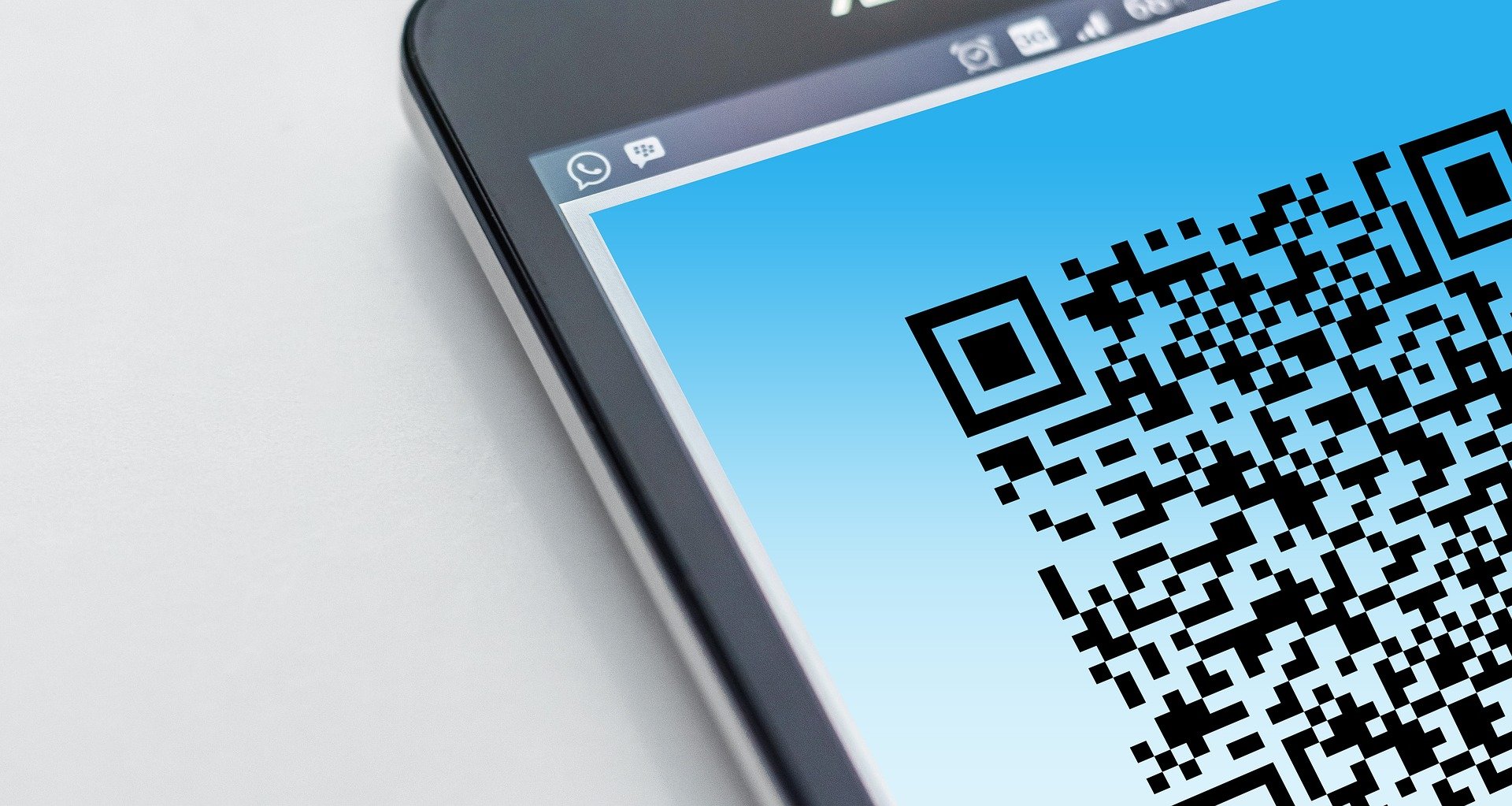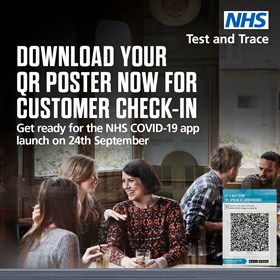A QR Code, which is short for Quick Response Code, is a square, two-dimensional barcode. It consists of lots of small black and white squares that resemble a randomly tiled mosaic. QR codes can hold significantly more data than ordinary barcodes and are easy to scan and process.
Initially developed for automotive tracking, QR codes have now permeated everyday life with a wide range of applications.

According to lexico.com, a QR code is a “machine-readable code consisting of an array of black and white squares, typically used for storing URLs or other information for reading by the camera on a smartphone.”
Short history of QR codes
The Japanese company Denso Wave developed QR codes in the 1990s. At that time, it was a division of Denso Corporation, a global components manufacturer that was formerly part of Toyota Motors. The company used the codes to track parts during manufacturing. The inventors applied the term “quick response (QR)” to emphasize the focus on rapid reading.
The idea spread to other manufacturers attracted by the fact that the new codes could store more information than barcodes.
Another reason for the rapid spread of QR codes was that while Denso held the patent for the invention, they decided not to exercise it. Instead, they made the specifications freely available.
Since their invention, use of the two-dimensional barcodes has spread beyond manufacturing. Engineering, construction, and retail industries use them to track goods and supplies. Postal services use the codes to track parcels.
The ability to scan and process the data-rich codes with a smartphone has also greatly widened their range of use. Advertisers use them to encode website addresses and product coupons. Organizers of concerts and sporting events put them on tickets.
The coronavirus (COVID-19) pandemic has given fresh impetus to QR code use. The fact that you can scan the code straight into your smartphone without having to touch or key anything is a big draw.
Advantages of QR codes
A big advantage that the two-dimensional codes have over barcodes is that they can store more information. Another is that they are easier to scan and produce fewer errors. They can also be made more secure. The following sections explain these advantages further:
Information capacity
Conventional barcodes can store up to around 20 digits. In contrast, QR codes can handle dozens to hundreds of times more data of different formats. For instance, in addition to alphanumerics, they can store Kanji and Kana characters from the Japanese writing system.
Ease of scanning
To scan and interpret barcodes, you need special technology. However, anyone with a modern smartphone can now scan and decode a QR code. This ability has led to a massive increase in use of QR codes in many areas. It has opened up opportunities, for instance, for marketers to interact and engage with consumers directly through their mobile phones.
Error reduction
While it does not happen very often, barcodes can produce errors. Shoppers may occasionally experience this at the checkout. The scanner may register a completely different item. This happens much less often with QR codes. This is because their greater data capacity means that there is room to build in fail-safes.
Security
It is possible to make the information in a QR code private by encrypting it. In this way, only those with the right cryptographic key and scanner can read the information.
It is also possible for a single QR code to hold both public and private data. The private code looks like the regular public code, which helps to prevent tampering and forgery.
How do they work?
Barcodes can only be read horizontally. However, scanners can read QR codes both vertically and horizontally.
To the human eye, the pattern of a QR code seems to lack form or structure. But to the QR scanner, different areas of the mosaic mean different things. As well as the area that contains the encoded data, there are several other parts, including:
- Quiet zone: This is the white space around the image that confirms that it is a QR code.
- Finder pattern: This comprises three squares located at top left, top right, and bottom left of the code. It helps the scanner to recognize a QR code and its orientation.
- Separators: The thickness of a small square, these usually white areas help the scanner to distinguish the finder pattern from the rest.
- Timing pattern: Made up of lines of alternating black and white squares, this pattern tells the scanner how big the squares are so that it can identify individual ones.
- Alignment pattern: This pattern is usually a small square near the bottom right corner. It helps to ensure that the scanner can still read the code if the image is slightly distorted or misaligned.
- Format and version information: These areas store details about the type of QR code in the pattern. For instance, they tell the scanner about the level of error correction and the type of masking pattern to use in decoding.
What can you put in a QR code?
A large capacity for data means that QR codes can store many different types of information. A section of the code tells the scanner what type of data it contains.
The following list shows some of the common applications for smartphone users. Depending on the setting in the smartphone’s scanning app, the result can be the immediate appearance of the associated destination.
- Website address: For instance, scanning a product’s QR code in a store can take you to the site where you can see more information about it.
- Pre-filled emails: With subject line and recipient already filled in ready for the user to insert their message.
- Contact details: Complete with name, phone number, email address, website, and other information. Business cards can now feature QR codes so that people can easily scan the information straight into their digital address books.
- Appointment details: With date and information about events that users can save directly into their digital diary. Wedding invitations, for example, can carry QR codes with these details.
- Pre-addressed messages: Like the pre-filled email idea, scanning the QR code on a smartphone can bring up a new SMS with the recipient already filled in. The user just types in the message.
- Phone numbers: This works in a similar way to the pre-filled email and pre-addressed text message. Scanning the code reveals a phone number that can be dialed or saved.
- Alphanumeric strings: The QR code can also carry plain text that only means something to an application that is already installed on the smartphone or reading device.
The following sections describe two particular uses of QR codes: one commercial and one to do with public health. In both cases, the trigger has been the COVID-19 pandemic.
Contactless drink pouring
In 2020, the Coca-Cola Company launched a contactless “mobile pour” method for dispensing drinks. This allows consumers to rapidly choose and pour a drink from a fountain dispenser into a cup without having to download an app or apply for membership.
The customer positions their cup under the dispenser’s spout and scans the QR code displayed on the machine. This action summons the user interface to the smartphone. From there, the user can choose their drink options and control pouring using a button on their phone screen.
Coronavirus lockdowns in the United States spurred Coca-Cola to develop the touch-free method.

Tracking disease spread
Another example of QR code use that the pandemic has spurred is in tracking virus spread in England and Wales. Businesses, restaurants, cafes, places of worship, and other establishments in those countries can generate their own unique QR codes.
As visitors to a venue arrive, they scan the venue’s code using a dedicated NHS COVID-19 app on their phone. The app is a central element of the virus testing and tracing system in England and Wales. Coupled with symptom and test tracking, the venue information helps to identify hot spots so alerts can be sent to individuals who checked in at the venues affected.

Main types
Denso Wave give six main types of QR code:
- Models 1 and 2: The familiar, original pattern and an improved version with more capacity. Today, the term QR code usually refers to this regular type. Its capacity ranges from 1,067 to 7,089 numerals.
- Micro: A smaller, more compact version of the regular type. The Japanese company devised it for applications requiring less data and where space might be tight, such as on small parts. Its capacity is up to 35 numerals.
- iQR: This type encodes more data in the same size of space as the original. It can also be square or rectangular, the latter being an advantage for labeling long, small objects.
- SQRC: While this type looks like the regular one, it can contain encrypted data that only a dedicated scanner can interpret.
- Frame: These are regular QR codes but they incorporate a canvas area that can be used to display an image, logo, or brief message. The encoded data wraps around the canvas area much like text in a word processor document can wrap around an image.
- Dynamic: Recent developments have enabled dynamic QR codes which can be edited after being printed, adding versatility to their use.
Beware of scams
One of the many advantages of QR codes is that they are so easy to scan with a smartphone. But it is important to remember that the scan also triggers actions inside the device. Because the human eye cannot see what the code contains, there is an element of risk.
One of the most common actions that can follow a scan is that it presents a weblink. But before you click on it, ask yourself if the link is genuine and safe. How do you know that it won’t take you to a site that might steal personal data?
It is not difficult to create a QR code and have it direct the scanner to a given destination. This increases the opportunity for scammers.
Before you scan, consider the context. Think twice about scanning a code on a poster that promises a reward in return for filling in the form that it activates. The code could trigger the download of a malicious app that grabs the data.
If you are in a restaurant or hospital, perhaps you can place more trust in their poster.
One suggestion for adding a layer of protection is to check the settings on the app that you use for QR code scanning. Make sure that there is an extra step between scanning and subsequent action so that you can choose what happens next. For instance, make it present you with a weblink that you have to click on rather than take you directly to the website.
However, if in doubt, it is perhaps best not to scan.
